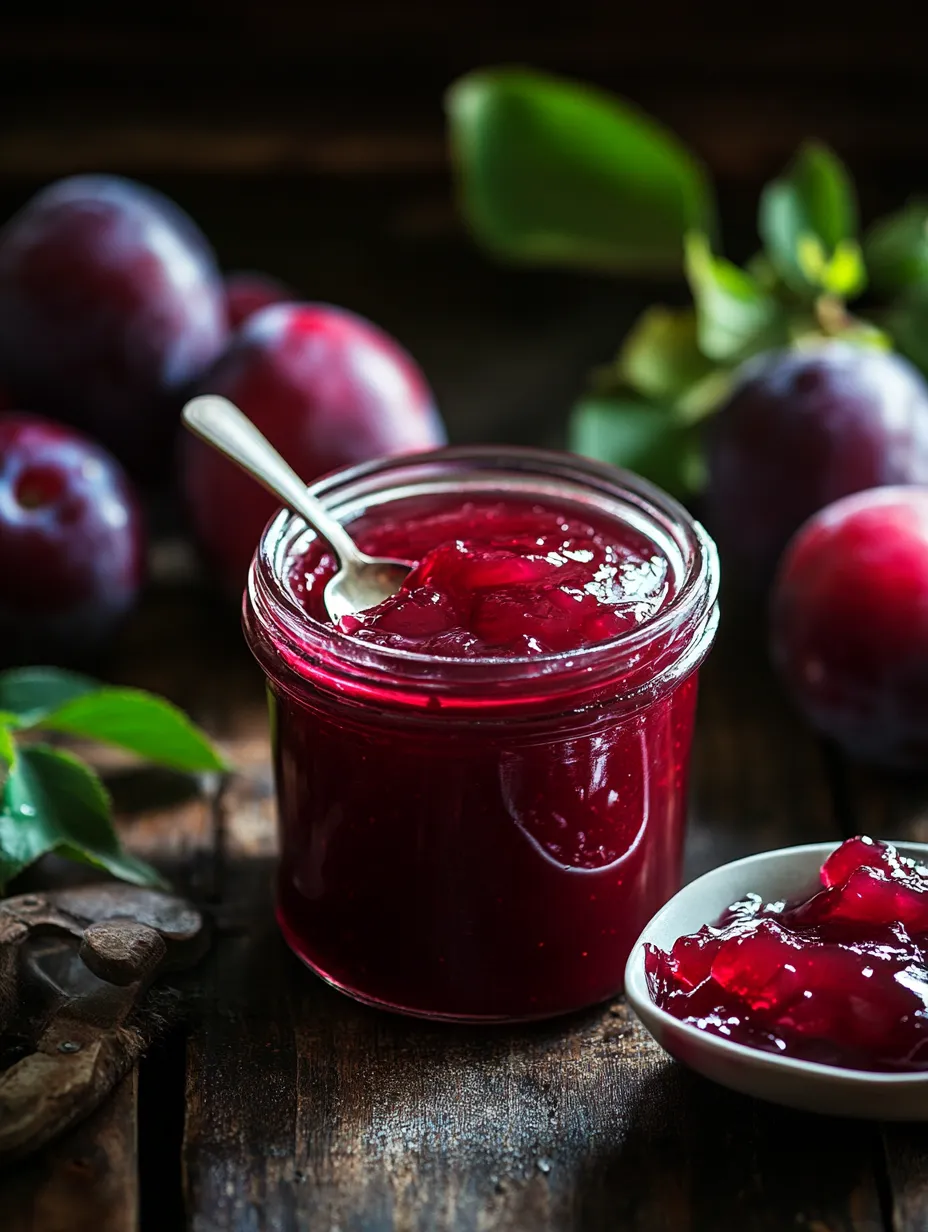This plum jelly recipe is a family favorite, passed down from my grandma. It’s the perfect way to preserve the sweet and tart flavor of fresh, ripe plums. You’ll be able to enjoy the taste of summer all year round! This plum jelly recipe is surprisingly easy to follow, so even if you’re a beginner jelly maker, you’ll be able to create a beautiful, vibrant, and delicious jelly. I can’t wait for you to try it!
Why This Plum Jelly Recipe is Special
This plum jelly recipe is unique because it uses a simple method to extract the natural pectin found in plums. This means you don’t need to add any commercial pectin! We’ll also add a touch of cinnamon, which gives the jelly a warm, inviting flavor that perfectly complements the natural sweetness of the plums. For more delicious recipes using fresh fruit, check out our chow chow recipe.
Ingredients You’ll Need
- 4 pounds ripe plums (Italian prune plums or Damson plums are excellent choices, but any variety will work)
- 1/2 cup water
- 1/4 teaspoon ground cinnamon (optional, but adds a lovely warmth)
- Sugar (amount will depend on the sweetness of your plums and your preference; see instructions)
- 1/4 cup lemon juice (freshly squeezed is best)
Fresh Plum Selection and Preparation
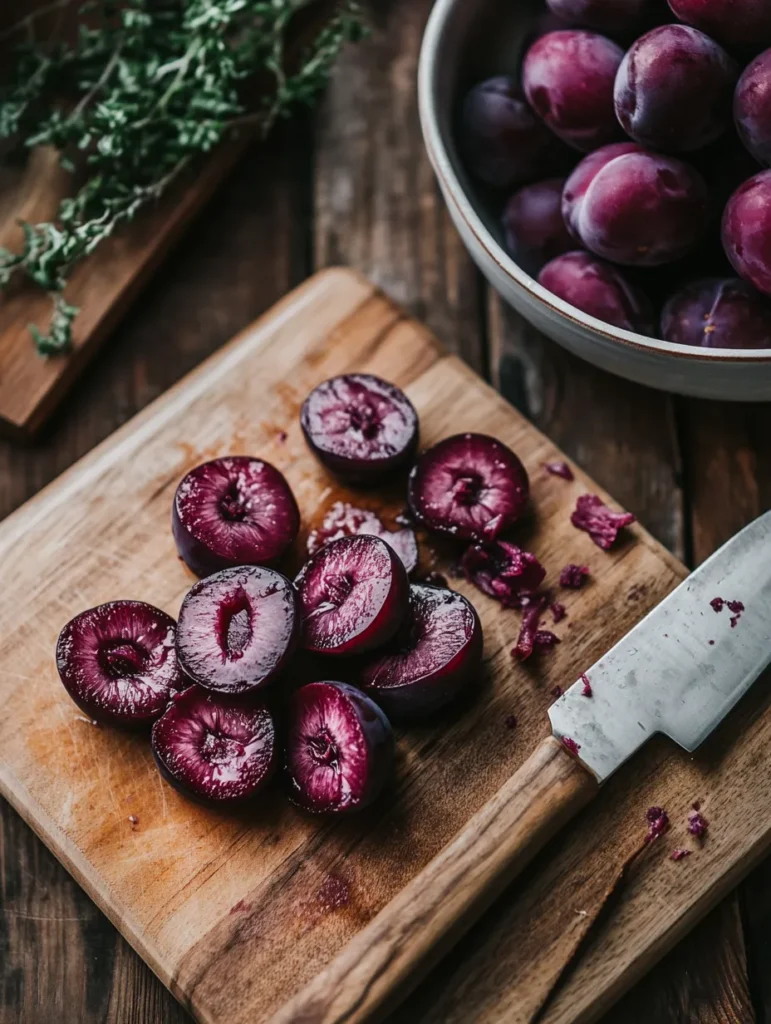
Choose plums that are ripe but not overripe. They should be slightly soft to the touch with a vibrant color. Avoid plums that are bruised or damaged. Wash the plums thoroughly under cold water. Then, cut each plum in half and remove the pit. You don’t need to peel the plums for this recipe, as we’ll be straining the pulp later.
Equipment for Making Plum Jelly
- Large pot (at least 8-quart capacity)
- Potato masher or wooden spoon
- Fine-mesh strainer or cheesecloth
- Large bowl
- Measuring cups and spoons
- Canning jars with lids and rings (half-pint or pint size)
- Canning funnel (makes filling the jars easier and less messy – [affiliate link to a recommended canning funnel])
- Jar lifter (essential for safely handling hot jars – [affiliate link to a recommended jar lifter])
- Large stockpot or canner for sterilizing jars
- Labels and pen (optional, but helpful for identifying your delicious jelly)
Sterilizing Jars and Equipment
Sterilizing your jars and lids is crucial for preventing spoilage. Wash the jars, lids, and rings in hot, soapy water. Rinse them well. Place the jars in a large stockpot or canner, covering them with water. Bring the water to a rolling boil and boil for 10 minutes. Keep the lids and rings in simmering water until you’re ready to use them. This ensures your plum jelly stays fresh and safe to enjoy. If you enjoy canning, you might also like our baked beans recipe, which is perfect for preserving.
Step-by-Step Plum Jelly Recipe Instructions
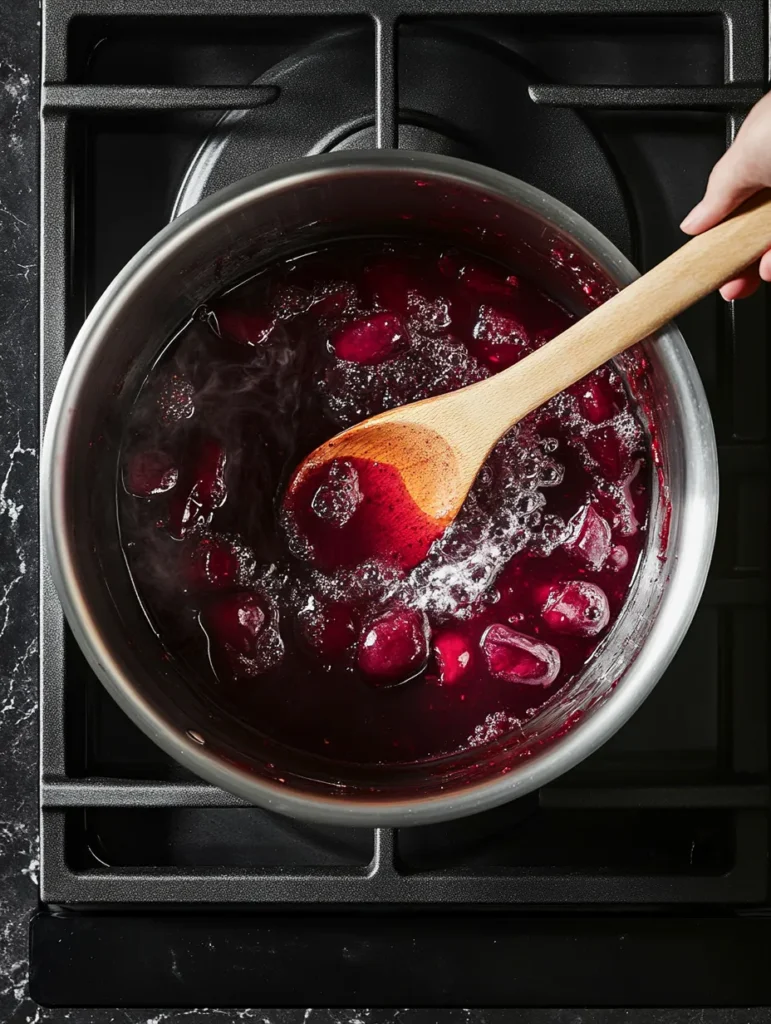
Simmering plum juice with sugar and cinnamon releases its vibrant flavors and natural pectin
Combine Plums and Water
In your large pot, combine the pitted plums and water. The water helps prevent the plums from sticking to the bottom of the pot as they begin to cook.
Cook and Mash
Bring the mixture to a boil over medium-high heat. Reduce the heat to medium-low and simmer for about 20-30 minutes, or until the plums are very soft. Use a potato masher or wooden spoon to break down the plums as they cook. This helps release the juices and pectin.
Strain the Plum Mixture
Place your fine-mesh strainer or several layers of cheesecloth over a large bowl. Carefully pour the cooked plum mixture into the strainer. Allow the juice to drain through, gently pressing on the solids with the back of a spoon or spatula to extract as much juice as possible. Don’t force it, as this can make the jelly cloudy.
Measure the Juice:
Measure the amount of plum juice you have. This is important for determining the correct amount of sugar to add.
Cook the Juice with Sugar and Cinnamon
Pour the measured plum juice back into the pot. Add the cinnamon (if using). For every cup of plum juice, add ¾ cup of sugar. So, if you have 4 cups of juice, you’ll add 3 cups of sugar. You can adjust the sugar to your preference later.
Add Lemon Juice
Stir in the lemon juice. The lemon juice helps the jelly set properly and adds brightness to the flavor.
Bring to a Rolling Boil
Bring the mixture to a rolling boil over high heat, stirring constantly. A rolling boil is a vigorous boil that doesn’t stop even when you stir. This helps activate the pectin and achieve a good jelly set.
Test for Set
After about 10-15 minutes of boiling, test for the jelly set (see instructions below).
Fill the Jars
Once the jelly has reached its setting point, remove it from the heat. Ladle the hot jelly into your sterilized jars, leaving about ¼ inch of headspace at the top.
Seal and Process
Wipe the rims of the jars clean, place the lids on top, and screw on the rings fingertip tight. Process the filled jars in a boiling water bath for 10 minutes (adjust processing time according to your altitude).
Extracting Plum Juice
Getting the most juice from your plums is key to a flavorful jelly. Chef Margaret Carter recommends cooking the plums gently and allowing them to macerate slightly before straining. “Don’t rush the process,” she advises. “Low and slow cooking helps break down the fruit and release all those wonderful juices.” When straining, use a fine-mesh strainer or cheesecloth to ensure you capture all the precious plum nectar. Resist the urge to squeeze the pulp too hard, which can result in a cloudy jelly. Instead, let gravity do most of the work, gently pressing the solids to extract the remaining juice. This patience will reward you with a clear, vibrant jelly bursting with flavor. For another great preserving recipe, try our cucumber kimchi recipe.
Testing for the Jelly Set
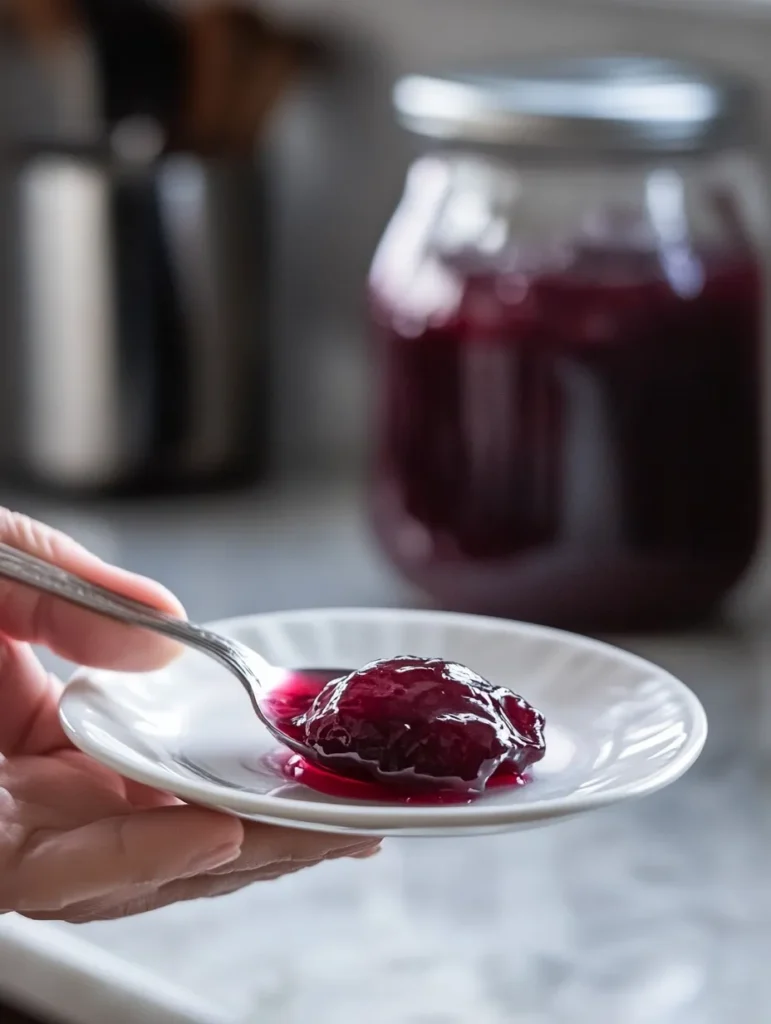
There are two main ways to test if your plum jelly has reached the setting point: the wrinkle test and the temperature test. For the wrinkle test, place a small spoonful of jelly on a chilled plate. Let it cool for a minute, then push the jelly with your finger. If it wrinkles or forms a skin that doesn’t run back together, it’s ready. The temperature test involves using a candy thermometer. The jelly should reach 220°F (105°C). This is the gelling point for most jellies. Using a thermometer is a more precise method. For more information on the health benefits of plums, check out this article on plum benefits.
Canning Your Plum Jelly
Canning your plum jelly properly ensures it stays fresh and safe to enjoy for a long time. After filling the sterilized jars with hot jelly, leaving ¼ inch headspace, wipe the rims of the jars clean with a damp cloth. This removes any sticky residue that could prevent a proper seal. Place the lids on top and screw on the rings fingertip tight. Don’t overtighten!
Next, carefully place the filled jars in a boiling water bath canner or a large stockpot fitted with a canning rack. Make sure the jars are covered with at least 1-2 inches of water. Bring the water to a rolling boil and process the jars for 10 minutes. Adjust the processing time based on your altitude – check a reliable canning resource like the National Center for Home Food Preservation for specific recommendations.
After processing, carefully remove the jars from the canner using a jar lifter and place them on a towel-lined surface to cool completely. You should hear a “pop” sound as the jars seal. Once cool, check the seals by pressing down on the center of each lid. If the lid doesn’t flex, it’s sealed. If any lids haven’t sealed, store those jars in the refrigerator and enjoy them within a few weeks. Label and date your sealed jars and store them in a cool, dark place for up to a year. If you’re interested in learning more about preserving, take a look at this article on canning food safely.
Flavor Variations and Tips from Chef Margaret Carter
“Plum jelly is a wonderful canvas for flavor exploration,” says Chef Margaret Carter. “Don’t be afraid to get creative!” She suggests adjusting the sweetness to your liking by adding more or less sugar. “Start with the recommended amount, then taste and adjust. You can always add more sugar, but you can’t take it away!” For a richer flavor, Chef Margaret recommends using a combination of plum varieties. “Mixing different plums adds depth and complexity.”
Beyond adjusting sweetness and mixing plum types, Chef Margaret encourages experimenting with spices and other fruits. “A touch of ginger adds a warm, spicy kick,” she notes. “Or try adding a splash of balsamic vinegar for a tangy twist.” For those who prefer a smoother jelly, she suggests blending the strained plum juice before adding the sugar. “This creates a beautifully smooth, almost velvety texture.” Try our brookie recipe for a fun dessert option.
Spiced Plum Jelly
For a warm and aromatic spiced plum jelly, add whole spices like star anise, cloves, or cardamom pods to the simmering plums. Tie the spices in a small cheesecloth bag for easy removal. A single star anise, 2-3 cloves, or a few cardamom pods will add a delightful fragrance and flavor. Remove the spice bag before straining the plum mixture. The gentle infusion of spice creates a unique and comforting jelly perfect for autumn and winter.
Plum and Apple Jelly
Combining plums with apples creates a beautifully balanced jelly with a unique flavor profile. Use a tart apple variety like Granny Smith or Braeburn. Add 1 pound of chopped apples along with the plums in the initial cooking stage. The apples contribute pectin and a subtle tartness that complements the sweetness of the plums. This combination offers a delightful twist on traditional plum jelly, perfect for spreading on toast or using in pastries. Looking for other fruit combinations? Our apple crumble recipe for baby offers a simple and healthy option.
Frequently Asked Questions
Can you freeze plums and make jelly later?
Yes, freezing plums is a great way to preserve them for later jelly making! Simply wash, pit, and freeze the plums in a freezer-safe bag or container. When you’re ready to make jelly, thaw the plums completely before proceeding with the recipe. Freezing plums allows you to enjoy homemade plum jelly even when fresh plums are out of season.
What are the four required ingredients in a jelly?
The four essential components of any jelly are fruit, pectin, acid, and sugar. Fruit provides the flavor, pectin helps the jelly set, acid balances the sweetness and also aids in gelling, and sugar acts as a preservative and adds sweetness. This plum jelly recipe utilizes the natural pectin and acid present in the plums, simplifying the process.
Do I need to peel plums for jam?
Peeling plums for jam is entirely optional. While the skins contain pectin and contribute to the vibrant color of the jam, some people find the texture of the skins undesirable in the finished product. This recipe includes a straining step, which easily removes the skins, so peeling is not necessary. If you prefer a smoother jam, peeling might be a good idea.
Are plums rich in pectin?
The pectin content of plums varies depending on the variety. Some plums are naturally high in pectin, while others contain less. This recipe is designed to extract the natural pectin from the plums, regardless of the variety, resulting in a beautiful set. If you find your jelly isn’t setting as firmly as you’d like, you can always supplement with a small amount of commercial pectin. Follow the instructions on the pectin package for best results.
Serving and Storing Your Plum Jelly
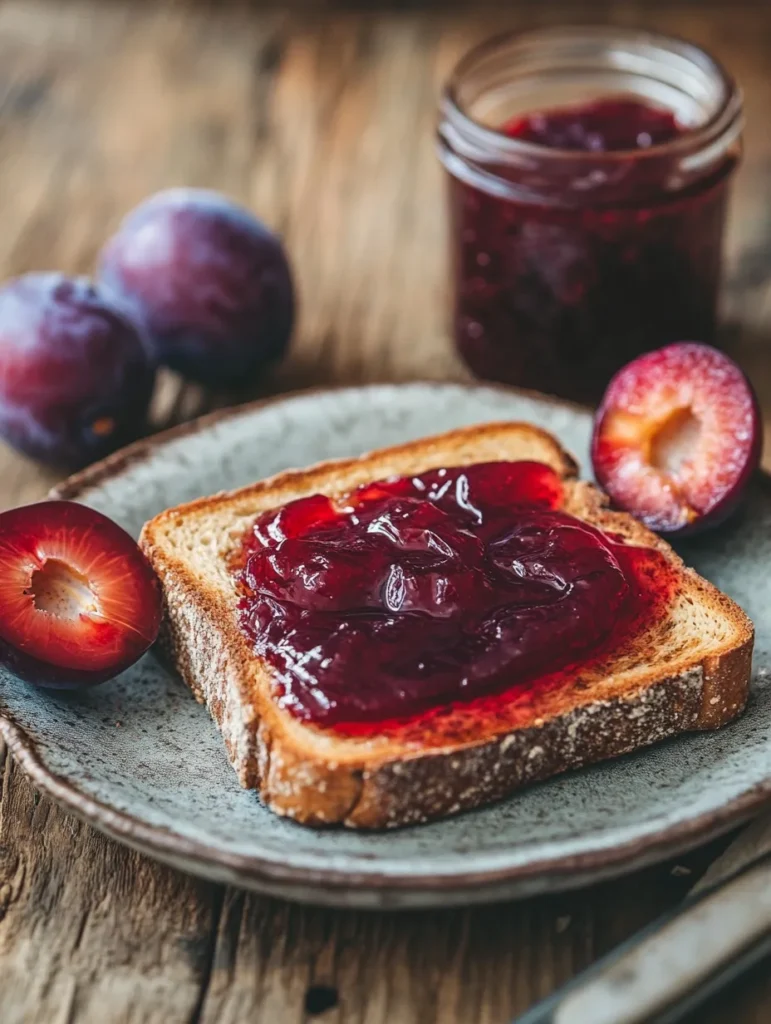
This homemade plum jelly is incredibly versatile. It’s delicious on toast, biscuits, or English muffins. It’s also a wonderful addition to cheese boards, pairing beautifully with creamy brie or sharp cheddar. For a sweet treat, try swirling it into yogurt or ice cream, or use it as a glaze for roasted meats like chicken or pork. For a truly decadent dessert, spread the plum jelly between layers of a cake or use it as a filling for thumbprint cookies.
Proper storage is key to maintaining the freshness and quality of your plum jelly. Sealed jars stored in a cool, dark place will last for up to a year. Once opened, store the jelly in the refrigerator for up to 3 weeks. Make sure to use clean utensils each time to prevent spoilage.
Gift Ideas with Plum Jelly
Homemade plum jelly makes a thoughtful and delicious gift. Package the jars in decorative boxes or baskets. Tie a ribbon around the jar and add a personalized label with the flavor and date. You could even include a small card with serving suggestions. For a special touch, pair the jelly with a loaf of homemade bread or a selection of gourmet crackers. A gift of homemade plum jelly is sure to be appreciated.
Conclusion
Making this plum jelly recipe is a truly rewarding experience, culminating in a delicious and beautiful treat that captures the essence of summer. The vibrant color and sweet-tart flavor will brighten any breakfast table or afternoon snack. I hope this recipe becomes a new family favorite for you, just like it is for mine.
Be sure to try this plum jelly recipe and let me know what you think! Share your experience and any variations you try in the comments below. For more delicious recipe inspiration, follow FlavoredRecipe on Instagram, Pinterest, and Facebook. And don’t forget to sign up for our newsletter to receive exclusive recipes and cooking tips straight to your inbox!
Print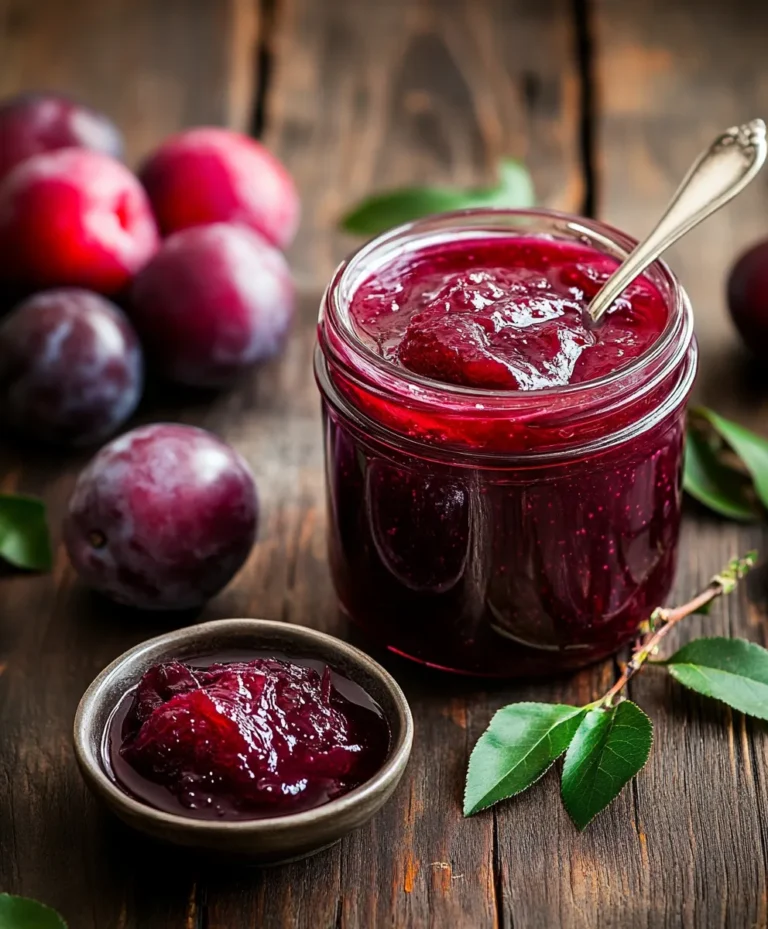
Plum Jelly Recipe: Easy & Delicious Homemade Jelly
- This plum jelly recipe is a family favorite, passed down from my grandma. It’s the perfect way to preserve the sweet and tart flavor of fresh, ripe plums. Even if you’re a beginner jelly maker, you’ll be able to create a beautiful, vibrant, and delicious jelly.
- Total Time: 1 hour 5 minutes
- Yield: 6 half-pint jars 1x
Ingredients
- 4 pounds ripe plums (Italian prune plums or Damson plums are excellent choices)
- 1/2 cup water
- 1/4 teaspoon ground cinnamon (optional)
- Sugar (amount depends on juice measurement; see instructions)
- 1/4 cup lemon juice (freshly squeezed)
Instructions
- Prepare the Plums: Wash the plums thoroughly, cut in half, and remove pits. No need to peel, as the skins will be strained out later.
- Cook the Plums: In a large pot, combine plums and water. Bring to a boil over medium-high heat, then reduce heat and simmer for 20-30 minutes until soft. Mash with a potato masher.
- Extract the Juice: Strain the cooked plums through a fine-mesh strainer or cheesecloth into a large bowl. Let gravity do the work to ensure a clear jelly.
- Measure the Juice: Measure the amount of strained juice. Use 3/4 cup of sugar for every 1 cup of juice.
- Cook the Jelly: Return the juice to the pot. Add cinnamon (if using) and lemon juice. Stir in the calculated sugar.
- Boil to Set: Bring to a rolling boil over high heat, stirring constantly. Boil for 10-15 minutes, then test for setting.
- Test the Set: Use the wrinkle test (place a spoonful on a chilled plate, let cool, then push with your finger; if it wrinkles, it’s set) or the temperature test (220°F or 105°C).
- Fill the Jars: Ladle hot jelly into sterilized jars, leaving 1/4-inch headspace. Wipe rims clean.
- Process the Jars: Seal with lids and rings, then process in a boiling water bath for 10 minutes (adjust for altitude if needed).
- Cool & Store: Let jars cool completely. Check seals before storing. Keep in a cool, dark place for up to a year.
Notes
- For a spiced variation, add a star anise or a couple of cloves while simmering the plums.
- If the jelly is too soft, you can reboil it with added lemon juice or commercial pectin.
- Plum jelly is perfect on toast, biscuits, or as a glaze for meats like pork or chicken.
- Prep Time: 20 minutes
- Cook Time: 45 minutes
- Category: breakfast /Dessert
- Method: Canning
- Cuisine: American
- Diet: Gluten Free
Nutrition
- Serving Size: 1 tablespoon
- Calories: 50 kcal
- Sugar: 13 g
- Sodium: 0 mg
- Fat: 0g
- Saturated Fat: 0g
- Unsaturated Fat: 0g
- Trans Fat: 0g
- Carbohydrates: 14 g
- Fiber: 0g
- Protein: 0g
- Cholesterol: 0mg
Keywords: plum jelly, homemade jelly, plum preserves, easy jelly recipe, canning recipe

